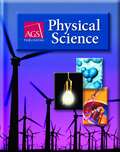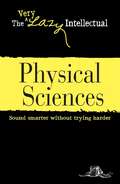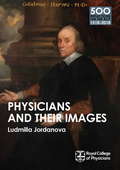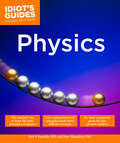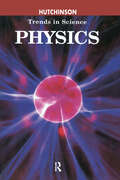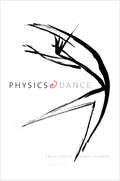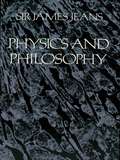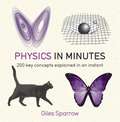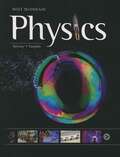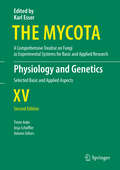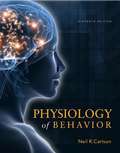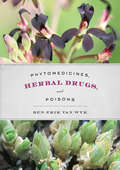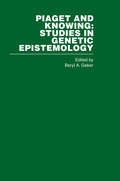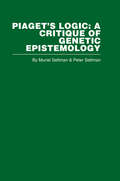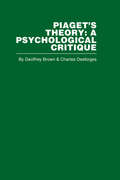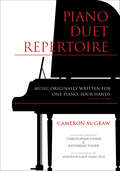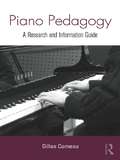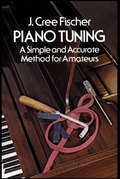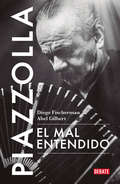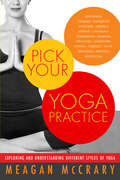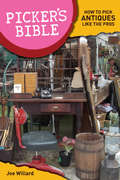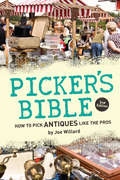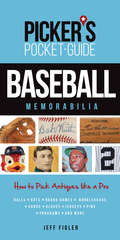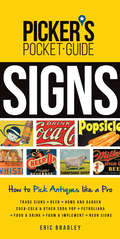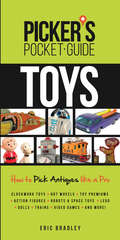- Table View
- List View
Physical Science
by Donald H. Jacobs Robert H. MarshallPhysical Science text, students learn the properties of matter, elements, compounds, electricity, and sound and light. Students reading significantly below grade level gain practice in working with data and sharpen their abilities to infer, classify, and theorize. Lexile Level 840 Reading Level 3-4 Interest Level 6-12 Features and Benefits Aligns with NCTM Standards ELL/ESL appropriate Track student progress with Skill Track Software Concepts presented in clear, simple language Problem solving and word problems encourage students to relate skills to real-life situations Relevant practice activities such as comparison shopping and figuring interest rates Supplemental problems for additional practice and review Calculator activities reinforce computation skills Over 300 additional activities available on the Teacherâ s Resource Library CD-ROM Research and Validity AGS Globe publishes high-interest, low-reading level textbooks, instructional materials, and assessments for students with a wide range of special needs. The purpose of this report is to document how AGS Globe textbooks are aligned with scientific research that supports best practices in pedagogy, instructional design, and instructional techniques.
Physical Sciences: Sound smarter without trying harder (The Very Lazy Intellectual)
by Adams MediaDid you avoid all but the easiest science courses in school? Wish you knew what the theory of relativity refers to? Fear not! Covering everything from earth sciences to astrophysics, The Very Lazy Intellectual: Physical Sciences introduces you to the world's most important scientific theories. With information on the Big Bang to the Manhattan Project, you'll learn just enough to hold your own in conversation.
Physicians and their Images
by Ludmilla JordanovaThe Royal College of Physicians celebrates its 500th anniversary in 2018, and to observe this landmark is publishing this series of ten books. Each of the books focuses on fifty themed elements that have contributed to making the RCP what it is today, together adding up to 500 reflections on 500 years. Some of the people, ideas, objects and manuscripts featured are directly connected to the College, while others have had an influence that can still be felt in its work.This, the eighth book in the series looks at the art and portraits of the Royal College.
Physics (Idiot's Guides)
by Paul V. Pancella Marc HumphreyPhysics can be a complex and intimidating subject. Idiot's Guides: Physics breaks down the complex topics of physics and makes them easy to understand. Readers will learn from numerous examples and problems that teach all of the fundamentals — Newton's Laws, thermodynamics, mass, energy and work, inertia, velocity and acceleration, and more!
Physics Trends (Trends in Science)
by Chris CooperToday's fast-moving world of science will have far-reaching effects on all of our lives. Trends inScience is a series of of essential readings for anyone who wants to know more about how his or her future will be affected; as well, the series provides accessible and stimulating material for high school and college students, for researchers and librarians.All titles in the series provide: an introductory overview of the field in the last 100 years, reviewing the past but also predicting the new developments of the future; a detailed chronology of the most important milestones; an index of key terms and concepts; biographies of the most important scientists in each field and their role in shaping their particular branch of science; a listing of important Websites, a directory of organizations, and suggestions for further reading.
Physics and Dance
by Emily Coates Sarah DemersA fascinating exploration of our reality through the eyes of a physicist and a dancer—and an engaging introduction to both disciplines From stepping out of our beds each morning to admiring the stars at night, we live in a world of motion, energy, space, and time. How do we understand the phenomena that shape our experience? How do we make sense of our physical realities? Two guides—a former member of New York City Ballet, Emily Coates, and a CERN particle physicist, Sarah Demers—show us how their respective disciplines can help us to understand both the quotidian and the deepest questions about the universe. Requiring no previous knowledge of dance or physics, this introduction covers the fundamentals while revealing how a dialogue between art and science can enrich our appreciation of both. Readers will come away with a broad cultural knowledge of Newtonian to quantum mechanics and classical to contemporary dance. Including problem sets and choreographic exercises to solidify understanding, this book will be of interest to anyone curious about physics or dance.
Physics and Philosophy
by James JeansCan we have any knowledge of the world outside us other than we gain by the methods of science? Are we humans endowed with free will, or are we mere cogs in a vast machine that must follow its predestined course until it finally runs down? Is the world we perceive the world of ultimate reality, or is it only a curtain veiling a deeper reality beyond?In this strikingly lucid and often poetic book, one of the twentieth century's greatest scientists grapples with these age-old questions, achieving in the process a brilliant and non-technical exposition of the interrelationship between physics and philosophy. He begins by defining physics and philosophy, pointing out the difference in their respective attempts to explain physical reality and man's place in it. This discussion paves the way for an outline of epistemological methods in which the rationalism of thinkers like Descartes, Leibniz, and Kant is compared to the empiricism of Locke and Hume.Over the course of the book, in a manner that is careful and methodic but never dull, Jeans marshals the evidence for his startling conclusion: recent discoveries in astronomy, mathematics, sub-atomic physics, and other disciplines have washed away the scientific basis of many older philosophic discussions. Such long-standing problems as causality, free will and determinism, the nature of space and time, materialism and mentalism must be considered anew in the light of new knowledge and information attained by twentieth-century physical science. Even then, however, Jeans cautions against drawing any positive conclusions, pointing out that both physics and philosophy are both relatively young and that we are still in Newton's words, like children playing with pebbles on the sea-shore, while the great ocean of truth rolls, unexplored, beyond our reach.Although first published in 1943, nothing in physics has happened to affect Jeans's account in this book; it remains remarkably fresh and undated, a classic exposition of the philosophical implications of scientific knowledge.
Physics in Minutes
by Giles SparrowPhysics in Minutes covers everything you need to know about physics, condensed into 200 key topics. Each idea is explained in clear, accessible language, building from the basics, such as mechanics, waves, and particles, to more complex topics, including neutrinos, string theory, and dark matter.Following the latest scientific research proving that the brain best absorbs information visually, each description is accompanied by an illustration to aid quick comprehension and easy recollection. This convenient and compact reference book is ideal for anyone interested in how our world works.Chapters include: Newton's Laws of Motion, Schrodinger's cat, Magnetism, Superconductivity, Fission and fusion, Higgs Boson, Entropy, Dark matter.
Physiology and Genetics
by Timm Anke Anja SchüfflerIn the last decade the discipline of mycology has been substantially changed by new research technologies. In particular DNA-based tools for the investigation of fungal taxonomy, signal transduction and regulation, and biosynthetic potential have accelerated advances in mycological knowledge. This volume presents a selection of exciting issues on basic and applied aspects of fungal physiology and genetics. In 18 chapters renowned experts provide an overview of traditional as well as current and future aspects of potential application of fungi in biotechnology. The contributions can be used by scientists to keep up-to-date on the latest developments in the corresponding research area, and by students to familiarize themselves with the different topics.
Physiology of Behavior 11th Edition
by Neil R. CarlsonThis book presents an introductory text in behavioural neuroscience and an accessible portrait of the dynamic interaction between biology and behaviour.
Phytomedicines, Herbal Drugs, and Poisons
by Ben-Erik van WykPlants have been used to treat disease throughout human history. On a clay slab that dates back approximately five thousand years, the Sumerians recorded medicinal recipes that made use of hundreds of plants, including poppy, henbane, and mandrake. During the Middle Ages, monks commonly grew and prescribed plants such as sage, anise, and mint in their monasteries. And as the market for herbal remedies and natural medicine grows, we continue to search the globe for plants and plant compounds to combat our various ailments. In Phytomedicines, Herbal Drugs, and Poisons, Ben-Erik van Wyk offers a richly illustrated, scientific guide to medicinal and poisonous plants, including those used for their mind-altering effects. Van Wyk covers approximately 350 species—from Aloe vera and Ephedra sinica to Cannabis sativa and Coffea arabica—detailing their botanical, geographical, pharmacological, and toxicological data as well as the chemical structures of the active compounds in each. Readers learn, for example, that Acacia senegal, or gum acacia, is used primarily in Sudan and Ethiopia as a topical ointment to protect the skin and mucosa from bacterial and fungal infections, and that Aconitum napellus, more commonly known as aconite, is used in cough syrups but can be psychedelic when smoked or absorbed through the skin. With 350 full-color photographs featuring the plants and some of their derivative products, Phytomedicines, Herbal Drugs, and Poisons will be an invaluable reference not only for those in the health care field but also for those growing their own medicinal herb gardens, as well as anyone who needs a quick answer to whether a plant is a panacea or a poison.
Piaget's Logic: A Critique Of Genetic Epistemology
by Muriel SeltmanThis book was first published in 1985.
Piaget's Theory: A Psychological Critique
by G. Brown C. DesforgesThis book was first published in 1979.
Piano Duet Repertoire: Music Originally Written for One Piano, Four Hands (Indiana Repertoire Guides)
by Cameron McGrawSince the 1981 publication of the first edition, Cameron McGraw's Piano Duet Repertoire has been a trusted guide for duet performers. This second edition, edited and substantially expanded by Christopher and Katherine Fisher, brings the volume into the 21st century, adding over 500 new or updated composer entries and nearly 1,000 new work entries to the volume, a testament to the renewed interest in piano duet playing. Entries are arranged alphabetically by composer and include both pedagogical and concert repertoire. The annotations and the grade-level indications provide piano teachers a wealth of instructional guidance. The book also contains updated appendices listing collections and duet works with voice and other instruments. This new edition features a title index and a list of composers by nationality, making it a convenient and indispensable resource.
Piano Pedagogy: A Research and Information Guide (Routledge Music Bibliographies)
by Gilles ComeauPiano Pedagogy: A Research and Information Guide provides a detailed outline of resources available for research and/or training in piano pedagogy. Like its companion volumes in the Routledge Music Bibliographies series, it serves beginning and advanced students and scholars as a basic guide to current research in the field. The book will includes bibliographies, research guides, encyclopedias, works from other disciplines that are related to piano pedagogy, current sources spanning all formats, including books, journals, audio and video recordings, and electronic sources.
Piano Tuning: A Simple and Accurate Method for Amateurs (Dover Books On Music: Piano)
by J. Cree FischerIf you have a note that has dropped in pitch, do you have to call in the tuner? A stuck key? Sympathetic rattle? Missing bridles? A broken hammer shank? An unglued ivory? The answer, in each case, is no: you can make all of these repairs yourself!This is the clearest and most complete book available for beginning tuners and amateur pianists. It explains all the basic processes practically and with model clarity. A non-musician can use this book without too much difficulty.You will learn how upright, grand, and square actions work, and how to take care of the smallest repairs — repairing stuck keys, poorly adjusted bottoms and capstans, crowded back checks, felts and leather on the hammers, hammer stems; softening damper and hammer felts; installing new bridles; eliminating "sympathetic rattle"; all with a minimum of tools and training.You will learn a professional method of tuning based on slightly flattened fifths, where only the octave and the upward fifth intervals are used. This is one of the easiest systems to learn, one capable of a great deal of control, and one perfectly suited to adjusting one or two keys. It is a tested method especially right for amateurs working without a teacher, and a method that trains the ear for other recommended systems. The author also explains "beats," the theory of the tempered scale, and useful experiments you can make with harmonic phenomena.If you want to experiment with tuning a piano, there is no better book to start with. It will help performers and teachers make occasional repairs and learn the structure and scale of the piano. Those who want to know how pianos work will find this book both clear and useful.
Piazzolla. El mal entendido
by Diego Fischerman Abel GilbertPiazzolla. El mal entendido es la biografía definitiva de uno de los compositores de tango más importantes del mundo. La vida y la obra de Astor Piazzolla transcurrieron entre su demonización y el asombrado reconocimiento. Fue el emblema sonoro de una ciudad que buscaba estar a tono con su tiempo y sus aspiraciones. A un siglo de su nacimiento, esta nueva edición de Piazzolla. El mal entendido recupera la trama artística, cultural y política que acompañó al bandoneonista desde su aparición fulgurante junto a Aníbal Troilo hasta su inserción internacional más allá del tango. El ensayo intenta ser un puente crítico de acercamiento a una música que no deja de abrirse a nuevos sentidos y reflexiones. "Este libro siempre ha tratado de ser un puente (uno más) con aquello que nos legó Piazzolla, un modo reflexivo de acercamiento a lo que, primero, llegó como una vibración: el aire de Buenos Aires en movimiento", dicen Fischerman y Gilbert.
Pick Your Yoga Practice: Exploring and Understanding Different Styles of Yoga
by Meagan McCraryOn the surface it may appear that yoga is yoga is yoga, but take a closer look and you’ll discover myriad different yoga systems and lineages. There are dozens of yoga styles to choose from, and while yoga is for everyone, not every style is the perfect fit for every person. But how do you choose between mysterious-sounding names such as Ashtanga, Kundalini, Bikram, and Kripalu? As Meagan McCrary discovered when she began exploring different classes, finding the right style is essential for establishing a steady yoga practice. Pick Your Yoga Practice is the first book to describe the most prominent yoga styles in depth, including teaching methodology, elements of practice, philosophical and spiritual underpinnings, class structure, physical exertion, and personal attention. Those new to yoga will discover they have options and can confidently attend a class of their choosing, while experienced practitioners will expand their understanding of the vast world of modern yoga, and perhaps find themselves venturing into new territory.
Picker's Bible: How To Pick Antiques Like the Pros
by Joe WillardThe Science of Scrounging Whether readers are dumpster divers, estate sale addicts or modern archaeologists, this easy-to-use and informative guide to "picking" is guaranteed to improve their antiquing skills. The Picker's Bibleprovides great tips on where and how to find antiques for the best price. A fun and quick read, the book explains the ins and outs of negotiating price, things to avoid, secrets to success, and how to do it all better than the other guy. There is hidden treasure out there. . . Picker's Biblewill help you find it.
Picker's Bible: How to Pick Antiques Like the Pros
by Joe WillardThe Science of ScroungingWhether you're a dumpster diver, estate sale addict, or modern archaeologist, this easy-to-use and informative guide to picking is guaranteed to improve your antiquing skills. The Picker's Bible provides great tips on where and how to find antiques for the best price. A fun and quick read, the book explains the ins and outs of negotiating price, things to avoid, secrets to success, and how to do it all better than the other guy. There is hidden treasure out there . . . The Picker's Bible will help you find it!
Picker's Pocket Guide - Baseball Memorabilia: How to Pick Antiques Like a Pro (Picker's Pocket Guides)
by Jeff FiglerBrand New Ballgame Discover what the pros know with this hands-on, how-to guide to picking baseball memorabilia. Learn what seasoned collectors look for and what they value in this easy-to-follow and indispensable pocket guide. You'll Uncover:The Triple Play--Who, what, and how of baseball picking and collecting Hot Prospects--Baseball cards, balls, bats, jerseys, pennants, photographs, board games, and more Major League finds How to Play Ball--Practical strategies for valuing and flipping items The Sweet Spot--How to negotiate deals Whether for pleasure of profit, the Picker's Pocket Guide is a real find.
Picker's Pocket Guide - Signs: How to Pick Antiques Like a Pro (Picker's Pocket Guides)
by Eric BradleySigns of SuccessDiscover what the pros know with this hands-on, how-to guide to picking advertising signs. Learn what seasoned collectors look for and what they value in this easy-to-follow and indispensable pocket guide.YOU'LL UNCOVER:The best categories of signs: beer, Coca-Cola, petroliana, food and drink, farm and implement, home and garden, and neon signsPractical strategies from top buyers and sellersWhat to look for and where to find itHow to flip the signs you pickCommon fakes and reproductionsWhether for pleasure or profit, the Picker's Pocket Guide is a real find.
Picker's Pocket Guide - Toys: How to Pick Antiques Like a Pro
by Eric BradleyWelcome to Toyland!Whether it's a rare three-wheeled motorcycle that sold for $23,000 or an unopened LEGO set of the Millennium Falcon that can go for as much as $4,500, toy-box treasures are out there waiting to be found. Discover for yourself what veteran collectors know with this hands-on, how-to guide to picking toys, the No. 1 collecting category. Learn what seasoned collectors look for and what they value in this easy-to-follow and indispensable pocket guide.You'll uncover:The best toys to hunt for, including action figures, LEGO sets, model trains, space toys, teddy bears, tin toys, vehicles, oddities, and morePractical strategies from top buyers and sellersWhere to find hidden treasuresHow to flip toys for profit and funCommon fakes and reproductions Whether for pleasure or profit, the Picker's Pocket Guide is a real find.
